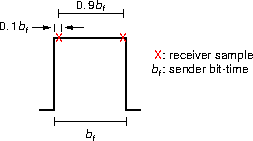An mB/nB encoding with m > n has some m-bit symbols that can't be encoded as n-bit symbols. If m > n, then 2m > 2n; that is, there are more m-bit symbols that there are n-bit symbols.
The minimum hop count is two when the two lower-level nodes have a link to the same upper-level node. The maximum hop count occurs when the two lower-level nodes have links to two different upper-level nodes, and the upper-level node addresses in the hypercube differ at every bit, such as 0000 and 1111 if n = 4. In that case, assuming an n-dimensional hypercube, the maximum hop count is n + 2: one hop to get up to the hypercube, n hops to move from one upper-level node to the other, and one hop to go down to the other lower-level node.
If channel bandwidth is zero, then Shannon's theorem gives the channel capacity as 0 · log2 (1 + S/N) = 0 bits/sec for any signal-to-noise ratio S/N. Such a condition could occur when the channel has a short or a break, such as when a wire is cut.
If the signal-to-noise ratio is 0, then Shannon's theorem gives the channel capacity as B · log2 (1 + 0) = B · log2 1 = B · 0 = 0 bits/sec for any bandwidth B. Such a condition could occur when the signal is equal to the noise on the channel; that is, it is impossible to distinguish between signal and noise.
False, for at least two reasons. First, two different objects Oi and Oj, i ≠ j, could collide in the ring; that is, they could map to the same address, which means they would be stored at the same node. Second, the number of objects that can be stored in C is larger than the number of ring addresses. If the number of objects stored in C is greater than the number of addresses in C, at least two of the objects have collided and there must be a node storing at least two objects.
False. Decoding errors occur if the receiver's bit time is outside the ±25% range, but they will also occur within that range too. Suppose the receiver's bit time is 0.9 of the sender's bit time (that is, the receiver is -10% of the sender), and the receiver samples the signal within the first 10% of a bit. Then the next sample the receiver takes will be from the same bit, a sampling error. If the receiver samples at some other portion of the bit, the sample point eventually drifts back to within the first 10%.
